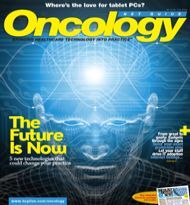Publication
Article
Oncology Live®
TechSectors: Connectivity: Improving Physician-Patient Communication
Author(s):
More than ever before, healthcare professionals are strapped for time.
More than ever before, healthcare professionals are strapped for time. The pressure of managed care, the need to deal with more patients in less time, and the ongoing care of an increasing number of patients who suff er from chronic disease make the task of eff ective physician—patient communication more challenging than ever. Particularly in the area of chronic care, the need for ongoing monitoring of a patient’s symptoms and the eff ectiveness of treatments require a long-term dialog with the patient. Wouldn’t it be wonderful if technology could provide a way for healthcare professionals to communicate more eff ectively with patients over time?
For many of us born before 1984, the Internet still feels like a relatively new tool, something we go to for information, and a network that allows us to send e-mail. Today, we are experiencing a new phenomenon, coined with the term “Web 2.0,” which is truly the next generation of how the Internet can be used. The concept of Web 2.0 sees the Internet as more than just a repository for information and embraces it for the unique opportunities it off ers for connecting people across the world. Most often, Web 2.0 is associated with blogs and social networking websites like MySpace or Facebook, where users share photos, interests, ideas, and anything else that fi ts on a Web page. In these settings, sharing information is fairly casual, social in nature, and done with little concern about confi dentiality.
Others are developing social networks and Web-based applications that enable people to connect with others in a more private, secure fashion, taking advantage of the dialog facilitated by Web 2.0 technologies. One of the hottest areas for development of this type of Web 2.0 application is “Health 2.0.”
Among the players in the Health 2.0 movement is ReliefInsite.com, a website dedicated to helping patients with pain to better communicate key aspects of their condition with their doctors and others caring for them. The HIPAA-compliant Web service functions like a patient diary. Using known and proven tools that have been in use in pain management over the past 30 years, the site collects and timestamps patient pain readings and related information.
ReliefInsite consists of a number of modules that allow patients to record pain location and intensity on gender-specifi c body map images; (A); note the characteristics of their pain, symptoms, and impact on lifestyle (eg, work, enjoyment of life); and track their medications and treatments. Th is information is organized into reports consisting predominately of charts and graphs that are easy to interpret and provide a longitudinal perspective of the patient’s condition (B).
The portal also functions like a virtual nurse that reaches out to patients to collect specifi c information about their condition and then responds to that information according to pre-defi ned protocols. Alerts can be sent to the patient when specifi ed thresholds have been exceeded. Rules associated with medication compliance or symptoms can be set up to notify the patient to take specific action. For those who do not use the Internet, an interactive voice interface enables patients to make their entries over the phone. This feature, in combination with automated reminders, helps to improve patient reporting adherence.
Whether made on the Internet or over the phone, all entries are aggregated into a secure online reports module, where they can be viewed, printed, saved, and shared with healthcare professionals.
As the business world embraces Web 2.0 social networking technology to improve communications with customers and constituents, the healthcare world needs to also take advantage of these technologies to create a more private space for secure interactions between healthcare providers and their patients. By automating and reporting on key aspects of information tracking and compliance monitoring, such sites provide more time for physicians and patients to have a focused and meaningful dialog about conditions and treatments.
Fred Eberlein is the Founder and CEO of ReliefInsite.










